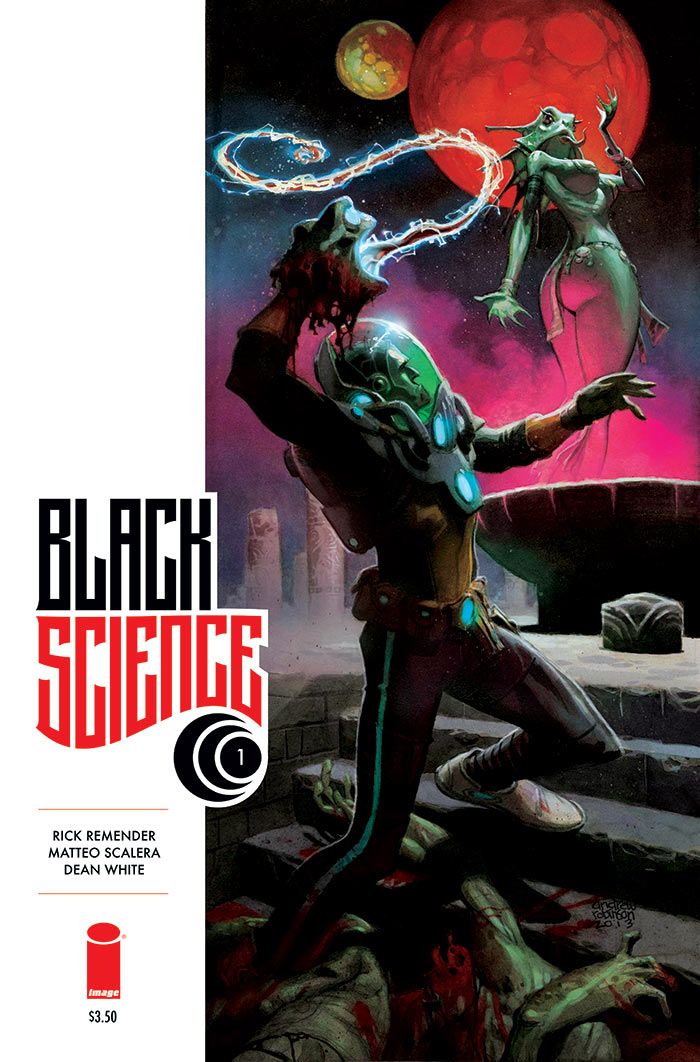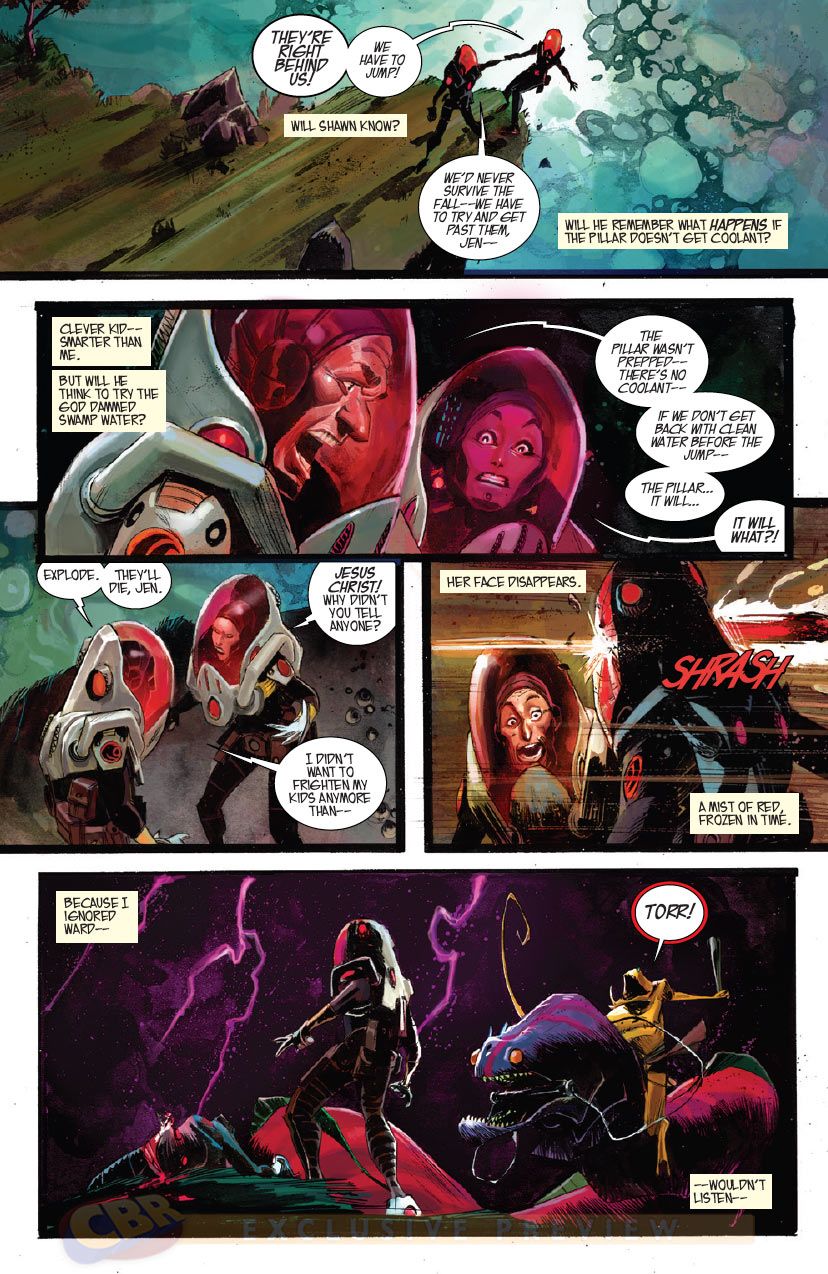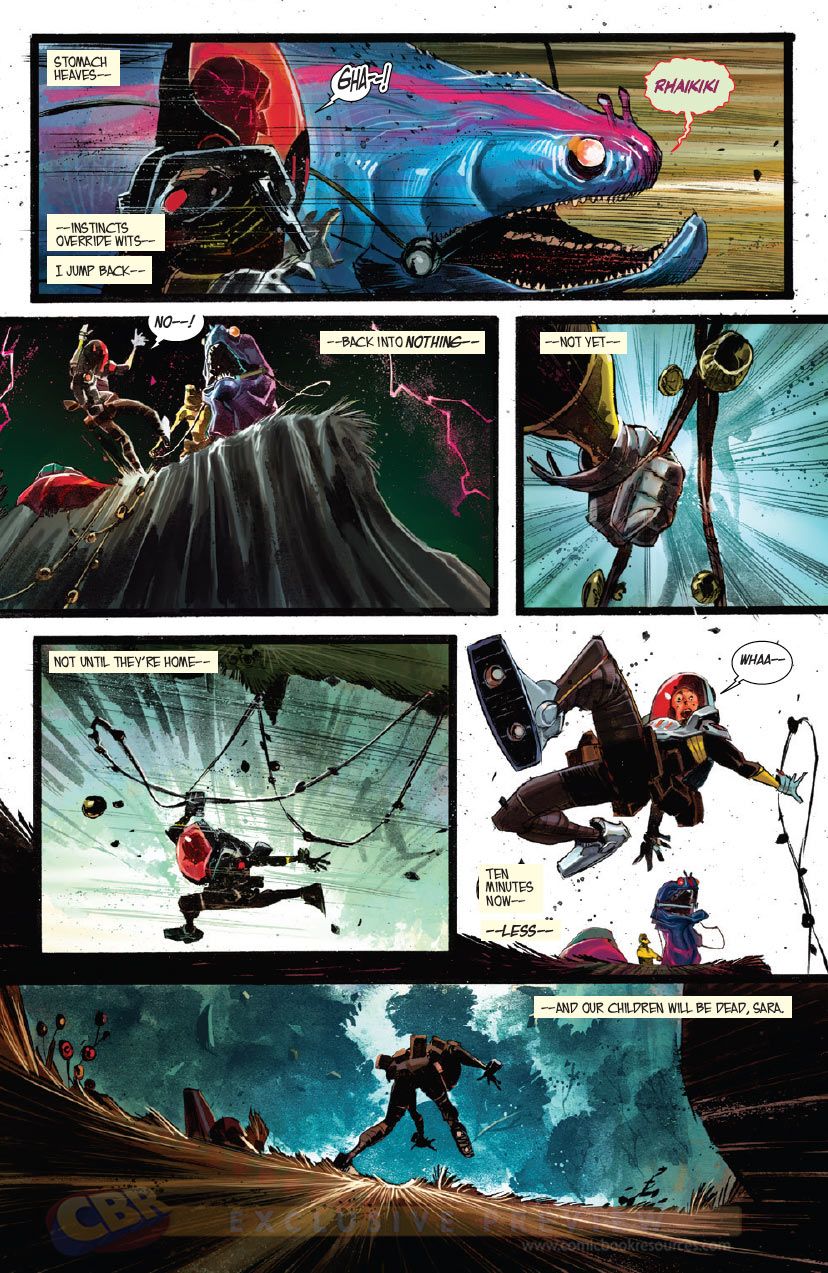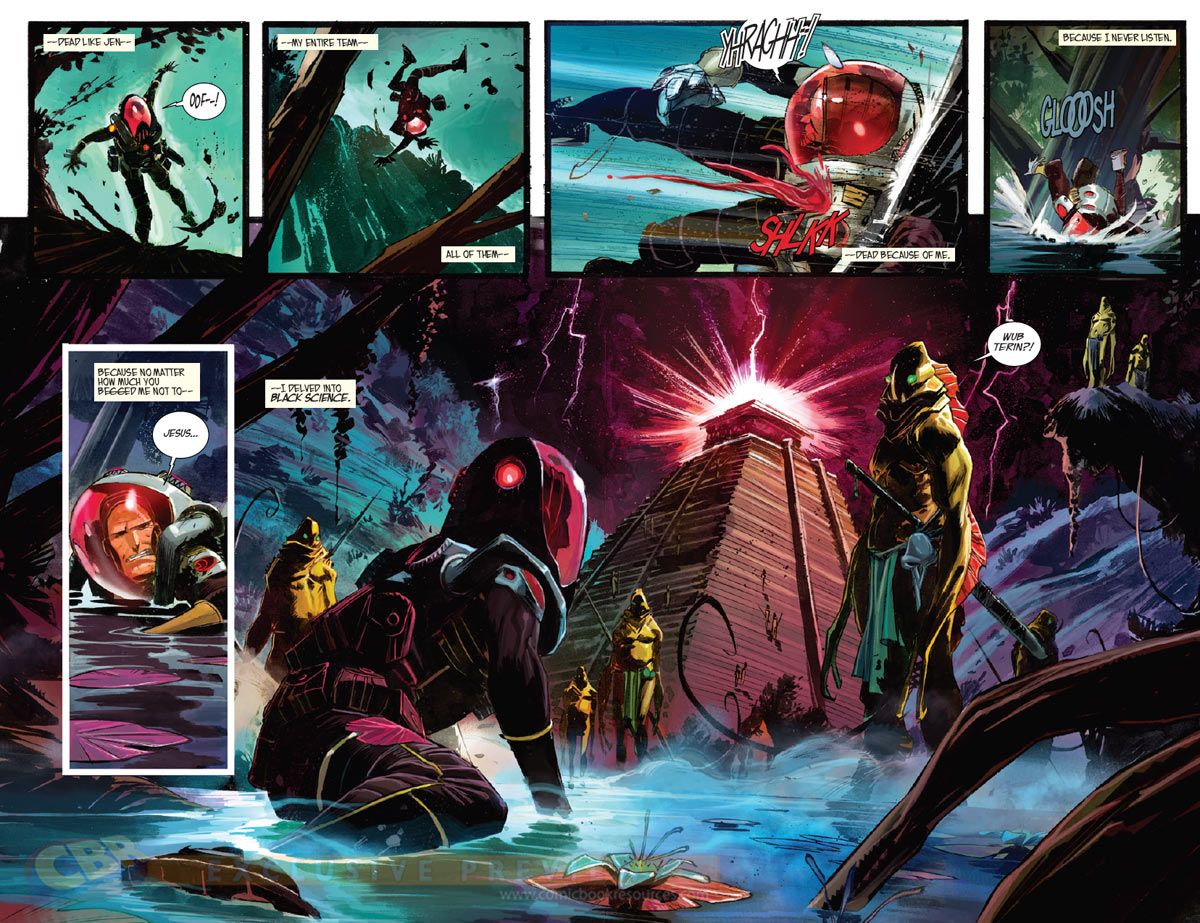For Grant McKay, there is no higher authority than himself. Although the genius scientist has unlocked the gateway to parallel dimensions and alternate realities, he never paused to ask himself about the moral implications of his work. A former member of The Anarchistic Order of Scientists, McKay has ignored convention in lieu of truth, forsaken conformity for enlightenment. It isn't until he and his crew find themselves trapped in a deadly, hostile world that he begins to realize the grave consequences of tampering with the secrets of the universe and the darkness within "Black Science."
Writer Rick Remender brings his formidable talent back to Image Comics this November, along with the top-of-the-line art team of Matteo Scalera and Dean White. The team spoke in depth with CBR News, giving us the inside track on what to expect from Grant McKay as he explores the forbidden realm of "Black Science."
CBR News: Rick, your body of work has been fairly pulpy, and it seems like a mode you've been really successful in. What do you love about the world of pulp meeting the world of Sci-Fi?
Rick Remender: The basic recipe I follow is taking a Saturday morning cartoon aesthetic and mixing it with true science and adult themes for a fully realized cast with identifiable motivations. I love to focus on wild ideas, and in a visual art form, such as comic books, it's mandatory to give the reader and artist a visual story. Lester Dent-style structure, pulpy sensibilities and classic Sci-Fi aesthetics deliver that when done right. This sensibility allows me to delve into big crazy ideas with a seedy underbelly, which I then decorate with fully realized characters with big hearts. When those things come together in the right balance I feel that's when I'm at my best.
I've always been drawn to science fiction with a touch of horror because it allows for an infinite amount of possible dilemmas for your characters, dilemmas that carry huge consequences, which is why I like to include a horror aspect. Peppering horrific fates throughout an adventure leaves you on pins and needles for the fate of the characters, which you hopefully have come to care for, and are rooting for.
Tell me about your hero, Grant McKay.
Remender: Grant, at his core, is an anarchist, a strident individualist. He believes that only the anarchist can accomplish the truly great feats. Only the self-taught can find their truth by exploring avenues barred by the fearful guardians of the status quo. He believes in, and has dedicated his life to, the Crass credo: "No authority but yourself." He has run his life based on this, often to the financial detriment of his family. He's a genius, disciplined and focused, a self-taught master of the black sciences forbidden by all governing bodies. He believes that a man can set out to teach himself and to master anything he desires provided he has the tenacity and the fire within. That a man can put in the time to investigate the facts, study and learn, vet many ideas form other experts, and to find his own truth.
We see Grant struggle with a lot of self-doubt through the first issue, examining his past actions and how he's prepared to deal with the consequences. During this series, will his desire to right past wrongs drive his actions?
Remender: Absolutely. He now recognizes what his fanatical adherence to the anarchist manifesto has cost those around him, especially his family. Of course he recognizes this far too late, and far too deep in danger. He's made a tremendous amount of mistakes based on his philosophy and adherence to it. The self-doubt is more of a realization that hits him when we open the story. A moment of clarity where he can finally see the consequences of the road he has walked.
Peppered throughout the first issue are mentions to things like Carl Sagan, parallel dimensions and string theory. Were these topics you were always interested in? What kind of research have you done for the technical parts of "Black Science?"
Remender: I've done quite a bit of research. The actual science behind parallel dimensions is one that's particularly fascinating; I love the idea that an infinite amount of parallel worlds exist only a fraction of an atom away from one another, and sometimes, even touch. The more I read about string theory the more my head hurts. It is a very complicated concept. But at its core is real science that reinforces much of what we've been doing in comic books for decades. So I took all of my research, got on the phone with my editor Sebastian Girner, and we took the basic structure of what is believed by modern scientists and put together our own version of it. With our own rules about how these things work and interconnect. That system is a big part of the story, the layers of the universe and exploration of them. We'll begin to dig into that stuff in later issues. Like all good pulp, it's fun fiction built upon reality, or at least theoretical reality.
The first issue is absolutely relentless -- lots of action, strange creatures, a totally alien environment -- all set to a frantic escape with a clock ticking. What are you hoping to establish by opening with such a frenetic first issue?
Remender: I think I am at my best when I am writing fluid action with an artist capable of depicting it to perfection. So after we had the outline for the first 15 issues worked out, I decided to start the story a good bit into it, dropping readers right into the middle of the chaos and slowly revealing how our cast ended up in this predicament, slowly revealing who they are. Much of who Grant thinks he is will be revealed in the first issue. But who we think we are, and who we actually are, or how others see us, is often very different. So I like the idea of giving readers a look inside a character's head, getting to know who the character thinks he is and how he perceives the world around him, and then show how other people see him. Opening up with the fast action sequence we can get inside his head as he is in the middle of dealing with the current danger, and that helps accomplish it. It sets the series pace and tone. It gives you a 007 cold open that tells you what to expect more of. While, hopefully, the same time, giving a very exciting and visual comic book that keeps people turning pages and learning to care for our hero.
Matteo, how did you develop the look of "Black Science?" It has such great classic sci-fi elements, with big reptile monsters, space suits and foreign landscapes -- were you a fan of the genre before this book?
Matteo Scalera: It was actually something that I didn't plan. For every new project that I'm on, first thing that I do is try to visualize it in my head. In my opinion, every book needs to have something that makes it different from the previous books. In this case, my style became a little bit less realistic, even for body proportions and facial expressions; I've also added some washes on my inks. In general, I don't consider myself as a sci-fi fan, I just love drawing, and "Black Science" is the perfect book for me, since it allows me to create new different worlds issue after issue.

What creatures or worlds were you most excited to draw?
Scalera: The first world that we see, which is dominated by reptiles, amphibians and fish, was just great since I love drawing those kind of animals, and I can go crazy with the proportions on bodies and faces. (I'm actually pretty proud of my fish-men, I must admit)
In general, the challenging thing about "Black Science" is that we move really quick from one world to another, so most of the time we don't have that much time to do studies for those specific worlds. Issue #2 is gonna be pretty challenging, since it involves things that I rarely draw. Obviously, I can't tell what it's about, but you'll find out once you get through issue #1's final pages.
Matteo and Dean, what is the breakdown of work like between the two of you with art and painting?
Dean White: Matteo lays down some great lines and washes in black and white, and then I take it from there and try to do my best.
Scalera: Dean's approach is really pictorial. I consider him as a painter, more than just a regular colorist. What he adds is on a different level. On the other side, given my studies, I'm a graphic artist, so the challenging thing here is trying to find the right equilibrium between these two worlds, which I think is pretty interesting. Hopefully the readers will like the final result, definitely something new in the industry that I'm very proud of.
Dean, you're mainly known for working on superhero titles. What was the draw to taking on "Black Science?"
White: Well, the concept and first issue script were fantastic. Also, Rick has always been incredibly supportive of what I do and has always brought me in as part of the team on any book I have worked with him. Having someone who catches all the small things you do and appreciates what color/painting brings to a book is great. Marry that with a fantastic concept, script and art, and I am in.
There's a bit of prose in the first issue -- "No tolerance for blind obedience, financial motivation, ego, or politicking for station. No rules but one -- There is no authority but yourself." Is this a reflection of the freedom of being on a creator-owned book?
Remender: It was written more from the perspective of a lone scientist, a stridentindividualist,who lives by these rules. Does it reflect doing creator-owned comics? Yes -- in part. Our motivations on "BlackScience"are for creative freedom. To make something that could only be made in creator-owned comics, something 100% true to ourintentions with nothing compromised. Not for ego, or to climb any ladder, but for the joyful freedom that comes from building something out of thin air with your friends. Seeing something you invented come to life, and to have other people take the journey, exactly as you intended it to be. Everyone on the team has a voice, and they are encouraged to use it. We all vet the work we're doing.
Everyonekicksin ideas and has a say. The cover design forexample, that has a bit of each of us in it. Everyone had a big idea that lead to that stunning trade dressing. Not the least of which is [letterer] Rus Wooton and his stunning logo. But there are many things that come from doing creator-owned comics, and intention, purecollaboration, and creative freedom top the charts.
Unlike Grant, however, we are hoping to make somemoney.
Scalera: Yeah, I think that here, we're all trying to be Grant, somehow. Kind of like a team of anarchists, trying to do their own thing in a world full of dangers. Well, OK, maybe that's a little too much, since we're talking about words and drawings on paper. But still, we're trying to do our part, taking our risks. Hopefully we've done the right thing and people respond to all the hard work!
"Black Science" will be available in stores on November 27th. Release date may vary by dimension.





